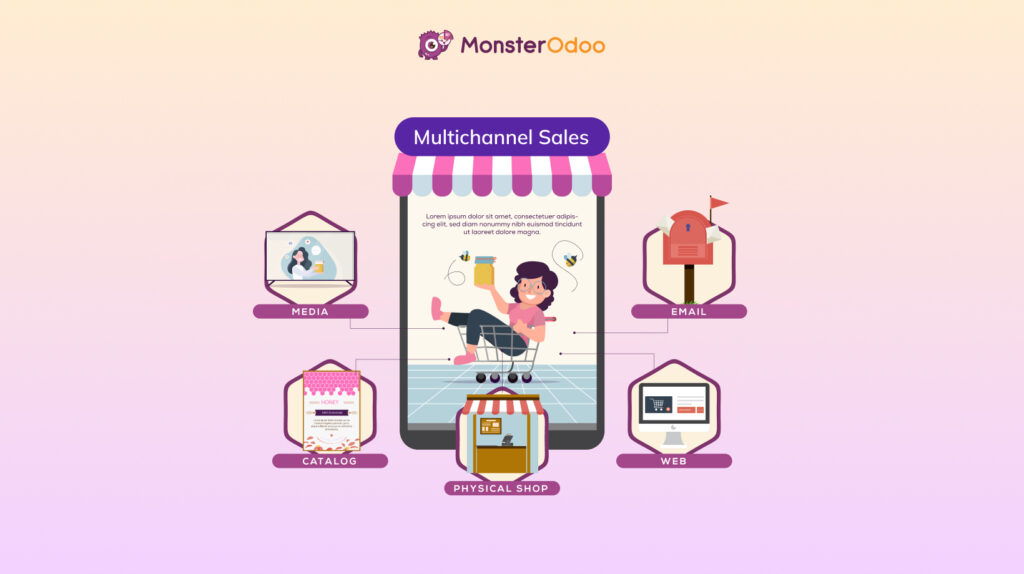In today’s dynamic business landscape, customer shopping behavior has evolved rapidly, with consumers seamlessly navigating between various sales channels to fulfill their needs. To stay competitive, businesses must embrace business solutions, which are multichannel sales approaches that enable them to reach and engage customers across a wide range of touchpoints. However, the true key to unlocking sustainable growth lies in adopting an integrated omnichannel sales strategy.

Business solutions: Understanding Multichannel and Omnichannel Sales
Multichannel sales refer to the practice of selling products or services through multiple distinct channels, such as physical stores, ecommerce websites, mobile apps, social media platforms, and marketplaces. While this approach allows businesses to expand their customer reach, it often results in siloed operations and inconsistent customer experiences across channels.
In contrast, omnichannel sales take the multichannel concept to the next level by seamlessly integrating all sales channels into a cohesive and seamless customer journey. With an omnichannel strategy, businesses can provide a unified and personalized experience, allowing customers to move fluidly between channels without disruption.
The Benefits of Adopting an Omnichannel Approach
Embracing an omnichannel sales strategy can unlock a multitude of benefits for your business:
- Increased Customer Reach and Accessibility: By making your products and services available across various channels, you can cater to a wider customer base and meet their preferences for how they wish to engage with your brand.
- Improved Customer Engagement and Loyalty: A consistent and personalized omnichannel experience can foster deeper customer relationships, leading to increased loyalty and repeat business.
- Enhanced Customer Experience and Satisfaction: Streamlined order processing, synchronized inventory, and seamless fulfillment can significantly improve customer satisfaction and overall brand perception.
- Streamlined Inventory Management and Order Fulfillment: An integrated omnichannel system allows for centralized inventory visibility and optimized order fulfillment, reducing operational complexities and costs.
- Improved Data-Driven Decision Making: By consolidating customer data across all channels, businesses can gain valuable insights to inform strategic decisions and drive continuous improvement.
Key Components of an Omnichannel Sales Strategy
Implementing a successful omnichannel sales strategy requires the seamless integration of several key components:
- Unified Product Catalog and Inventory Management: Maintain a centralized and synchronized product database to ensure consistent information and availability across all sales channels.
- Integrated Ecommerce Platform and Online Store: Invest in a robust ecommerce solution that can seamlessly integrate with your other sales channels and back-end systems.
- Synchronized Order Processing and Fulfillment: Establish a centralized order management system that can efficiently process, fulfill, and track orders from multiple channels.
- Consistent Branding and Messaging: Ensure a cohesive brand experience by aligning your visual identity, messaging, and promotional activities across all touchpoints.
- Centralized Customer Data and Analytics: Consolidate customer data from various sources to gain a 360-degree view of your customers and inform your omnichannel strategies.
Business solutions: Implementing Omnichannel Solutions
Transitioning to an omnichannel sales model requires careful planning and execution. Start by evaluating your existing sales channels and infrastructure to identify gaps and areas for improvement. Then, select an integrated ecommerce platform and enterprise resource planning (ERP) system that can facilitate the seamless integration of your online and offline sales channels.
Ensure that your product information, inventory levels, and order data are synchronized across all channels, allowing for real-time visibility and efficient fulfillment. Additionally, leverage data-driven insights to optimize your omnichannel operations and continuously enhance the customer experience.
Thriving with Omnichannel Solutions: Real-World Examples
Many businesses have successfully implemented omnichannel strategies to drive growth and gain a competitive edge. Take, for instance, the case of a leading furniture retailer that integrated its physical stores, ecommerce website, and mobile app. By providing customers with the ability to browse, purchase, and arrange for delivery or in-store pickup seamlessly, the retailer experienced a significant increase in sales, customer satisfaction, and brand loyalty.
Another example is a multinational apparel brand that implemented a centralized inventory management system and order fulfillment process. This allowed the brand to offer customers the flexibility to purchase online and pick up in-store, or return items purchased online to any physical location. As a result, the brand witnessed a substantial reduction in operational costs and an improvement in overall customer experience.
Conclusion
In the ever-evolving world of retail and commerce, embracing an business solutions is omnichannel sales strategy is no longer a luxury, but a necessity for businesses seeking to thrive and grow. By integrating your sales channels, optimizing operations, and delivering a seamless customer experience, you can unlock new opportunities for revenue growth, customer loyalty, and operational efficiency.
At MonsterOdoo, we understand the complexities of implementing an effective omnichannel sales solution. Our team of experts can help you navigate the journey, from assessing your current infrastructure to deploying a tailored omnichannel platform that aligns with your business goals. Unlock the power of omnichannel sales and propel your business towards a future of sustainable growth.



